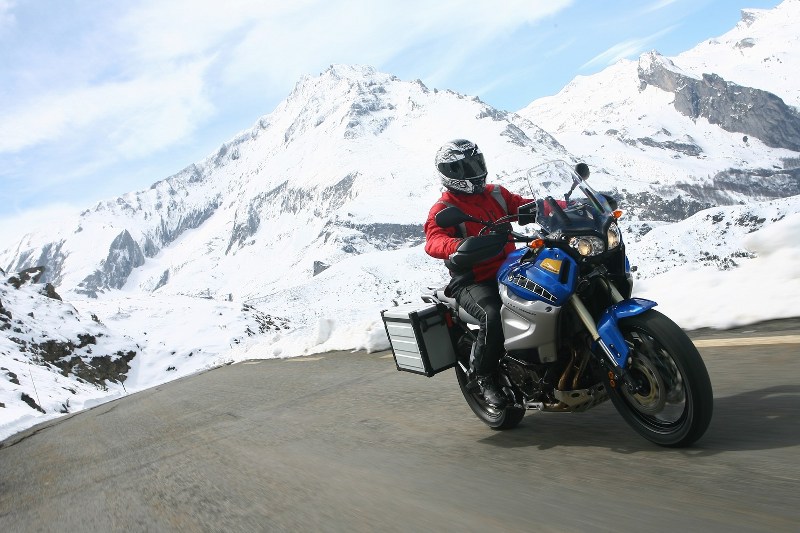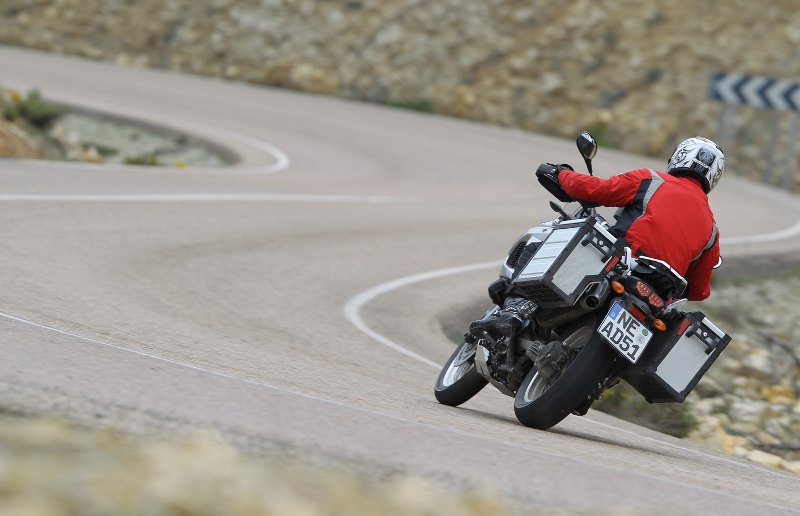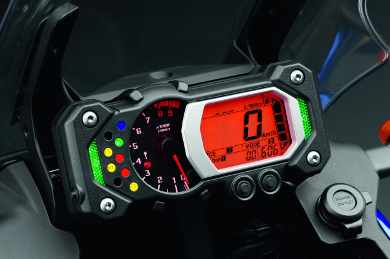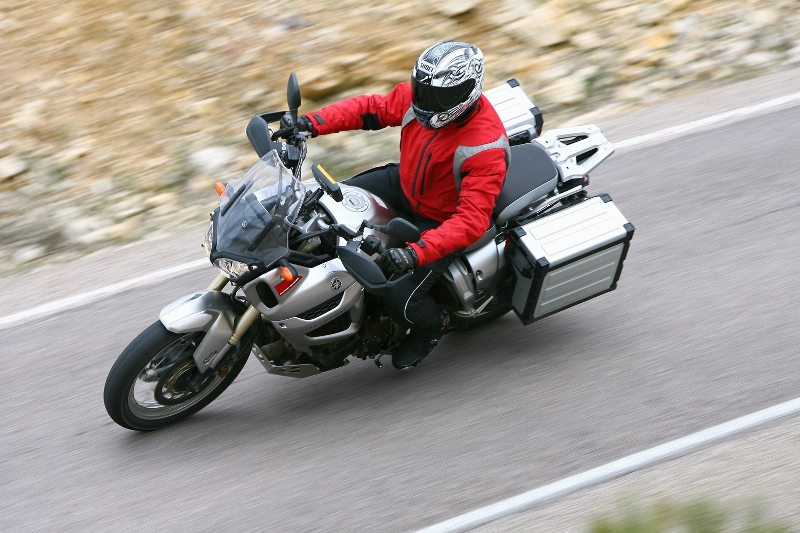
Ed’s Note: The following report on the European launch of the 2011 Super Ténéré comes courtesy of our friends at Solo Moto.
Tora! Tora! Tora! This was the call used by the Imperial Japanese Navy to announce a successful surprise attack. Yamaha has launched an attack on the large enduro category with its new Super Ténéré, but … has it achieved success?
For the most part, recent years have been very good to Yamaha, particularly when it comes to competition. One could say that in 2009 Yamaha took all the championships that matter most, including MotoGP, WSB, and World Supersport, among others. Once you have achieved all the sporting objectives, I suppose you look to regain dominance in categories you have recently ignored.

Introduced in the 1980’s the Super Ténéré and its single cylinder sibling found success in raids and Paris-Dakar. After the glory years, and the evolution of more powerful single-cylinder bikes, Yamaha discontinued its big twin.
But the big trail bikes have a long tradition, and remain very popular in Europe, perfect for any road travel, long tours or simple day-to-day riding.
The new Super Ténéré highlights all these qualities, but also incorporates modern technological advances like traction control, ABS with combined braking and throttle-by-wire. Our test of this new model took us across the Pyrenees into Spain … a trip of more than 1200 km (roughly 700 miles). In some ways a grueling two-day trip, but one that led us to an inescapable conclusion: the Super Ténéré is an outstanding motorcycle.
Let’s start with the new motor. An 1199cc parallel twin with four valve heads, DOHC, and fuel injection, peak power is 110 hp at 7250 rpm. With a broad, smooth band of torque it provides rapid acceleration. The MotoGP-inspired crankshaft firing interval is one of the most interesting points, and is similar to, in some ways, the crankshaft employed on the four-cylinder R1 sportbike.
The engine also incorporates balance shafts to minimize vibration. The dry sump design allows a lower placement of the engine. Despite the size and weight of the Super Ténéré, it handles very easily, and lightly. Surprisingly so. Adjustable ergonomics, in the form of two seat heights (845 mm and 870 mm) don’t hurt, either.
Like the R6 and R1 sportbikes, the Super Ténéré has Yamaha’s YCC-T system (throttle-by-wire) that monitors throttle position every millisecond. Improved throttle response and more precise fuel injection is the result. The system incorporates advanced traction control in three, selectable modes. The first prevents virtually all rear wheel slip, while another allows a moderate amount of slip for off-road. Finally, the traction control can be turned off entirely. The second setting was ideal for our 20 miles, or so, on slippery, gravel strewn trails, allowing some needed wheel spin, but never allowing us to get into trouble.
The Super Ténéré also features D-MODE selectable engine mapping, including “S” (for sport) and “T” (for touring). Sport mode provides maximum throttle response and power, while touring mode is a bit more relaxed and smooth. Personally, I preferred the sport mode which, combined with the traction control system, provided a safe but entertaining experience. Touring mode might add some additional measure of safety when riding in wet weather.
This is clearly a 21st Century motorcycle with electronics and technical sophistication akin to modern automobiles. The unified brake system with ABS is really exceptional. A computer program constantly monitors bike speed, deceleration and slip rates, in addition to wheel speeds to determine the point at which one or both wheels may be about to lose traction. The system also acts as a distributor of braking force between the front and rear brakes when the front brake lever is used (using the rear brake first defeats the brake linkage and allows the rider to control both front and rear manually). Overall, a very complex system that really works well. Without feeling artificial, it provides hard, bold braking that gives the rider confidence.

Virtually every journalist on the launch was surprised by the chassis of the new Super Ténéré. Although nearly 550 pounds wet, the bike handles extremely well at both low and high speeds. Yamaha kept the wheelbase short for this class of motorcycle, increasing agility, while also taking great efforts to lower the center of gravity and centralize mass. The Ténéré combined a nimble, playful feel with excellent stability.

Steel frame tubes were utilized for the frame, rather than aluminum, to better control shock and vibration for a bike that may frequently be used off-road. The suspension is also very refined, and performed well throughout our test.
The 43 mm inverted front fork did its job absorbing bumps while avoiding significant brake dive on corner entry. It is fully adjustable for preload, rebound and compression, and carries a 19-inch front wheel — better for off-road riding than a 17-incher.
The rear shock is adjustable for preload via a convenient knob that does not require tools. It acts through an aluminum swingarm that incorporates shaft drive.
That shaft drive system worked flawlessly at transmitting the engine power through to the rear wheel, shod with a Bridgestone Battle Wing tire that proved versatile enough to provide good traction in extremely varied conditions. None of the traditional bad behavior associated with shaft drive was evident.

The truth is that the new Super Ténéré surprised me. After more than 1000 km, I have to say that Yamaha has produced an excellent bike for the large enduro category. An outstanding motor housed in a very capable chassis that was quite comfortable and a pleasure to ride both on-road and off. With the large fuel tank the range is good … nearly 200 miles. The high tech aspects of the machine integrated well and did not interfere with an experienced rider’s enjoyment.
Unfortunately, for our U.S. readers, at this point we will not be able to buy a Super Ténéré in the States. Make sure you let Yamaha know if you want one here, because consumer demand always makes the difference. Take a look at this PDF if you want to see the Super Ténéré brochure, including specifications.
MD Readers Respond:
- I’d love to see the new Super Tenere up close and personal. It looks like my kind of motorcycle. I hope Yamaha USA sees fit to bring it stateside. Scott






Yamaha won’t bring it over, and with good reason. There aren’t enough motorcyclists here. Oh, there are plenty of people with motorcycles; just go for a ride on a Sunday if you want to see. We buy cruisers and crotch rockets, and a look at Honda and Yamaha’s U.S. lineup shows they understand this better than anyone. My local Triumph dealer is still trying to move a 2008 Tiger at a pretty significant discount. No trouble selling Rockets, though. A toast to Kawasaki and Suzuki for managing a more or less full range, but coloring outside the lines is risky, as any number of failed motorcycle launches can tell you.
Japanese motorcycle manufacturers have been repeatedly burned by Americans who demand certain types of motorcycles be developed or imported. These same people are then also notorious for buying them once they become available. (Examples: Suzuki SV1000, Honda Transalp, ad infinitum).
The Suzuki Vstrom 1000 (not the Vstrom “AKA Wee strom” 650) gives us a good fairly recent example of of this sort of reluctance. People said they wanted a big adventure touring bike of the type sold in Europe so Suzuki brought in the Vstrom 1000 which had originally been designed specifically for the European market. BIG mistake. Suddenly “the cold feet phenomenon” showed its ugly head once again. These perfectly good, practical bikes then languished in dealerships for a long time until the introduction of the very popular Vstrom 650 model somehow (surprisingly) rekindled interest in the larger bikes and the many 1000cc leftovers were then finally sold.
The same thing might well happen if the Super Tenere is introduced here. If history is any example, once this bike make an appearance here these faux potential purchasers will then bemoan the fact that the bike is either too big or too heavy or not powerful enough or too ugly or too expensive for a Japanese bike. The excuses for not purchasing them, if history gives us any example, will be endless.
The motorcycle magazines might well again assist in this debacle by letting a moto cross rider test the bike and give it a thumbs down because it doesn’t handle like a CRF250 or let it be tested by a road race rider who deems it a street slug. If you think this idea is wildly far fetched, think again. This is exactly what happened in the case of the late lamented Honda Transalp, a very practical, extremely reliable, very cheap adventure tourer which was almost universally slammed at the time because of either its purely dirt or road unworthiness by American magazine reviewers. (If memory serves me right, an perfect example of this general clueless attitude was exhibited by street testers of the bike who complained about the “vague feeling” of the its front end, seemingly oblivious to the fact that this same sort of road “vagueness” was common among dirt bikes because they, like the Transalp, sported more dirt capable 21 inch front wheels. The Transalp never found its niche and its importation to here was discontinued after only a few years because of poor sales. It has continued being popular in Europe and elsewhere where the overall practicality of the bike has always been more appreciated. It’s overall practicality has has make it a consistent seller overseas for many years. Honda had enough faith in its future to deem worthy of a significant model makeover just a few years ago.
The only hope for those of us who might actually buy a bike like this is to contact Yamaha at (800) 962-7926 and request that the bikes be built to order only after a good faith monetary deposit has been put down by potential purchasers. This is the same system that was used to introduced by the wary people at Yamaha to decide if there was a market over here for the Euro designed FJR1300s. Only the use of this sort of system will weed out the serial flakes among our brethren.
Our local Yamaha dealer said they were not bringing this bike to the states.(They were extremely frustrated) Hard to understand why they would not go after the US adventure touring market. Having owned a GS 1200 and now a KTM 990 Adventure, this would be a great addition to this market segment. Hope they see the light!!!
I love this bike. Yamaha flat NEEDS to sell the Tenere here. My only question is price. I hope it will be much less than the new Multistrada 1200. Consumers need to call Yamaha and tell them to bring this bike stateside. The BMW GS’s reign has finally come to an end!
Really Yamaha, it’s up to you…between this bike and the often imagined Off Road Tiger Cub that is always being hoped for…
If any of these bikes come to our shores, I am buying the first one I find!!
Great bike,hope yamaha doesn’t do what honda did with the varadero! Meaning not bring it to north america for years.I wanted a varadero but it was unavailable here so i bought a liter v-strom.I’ve been waiting for a 1200cc v-strom or varadero with no luck! Now yamaha has come out with a bike for me but not available! Too many models from Japan are not available here! Bad marketing i’d say!